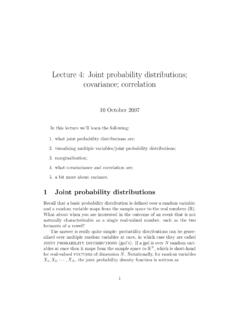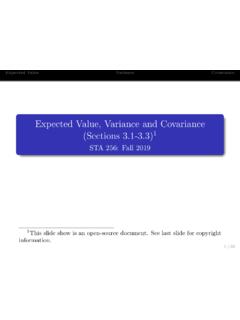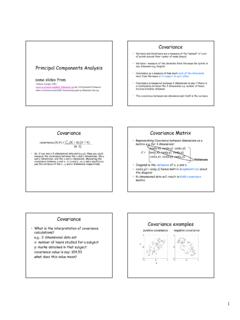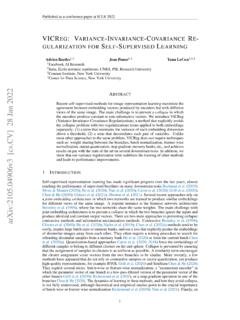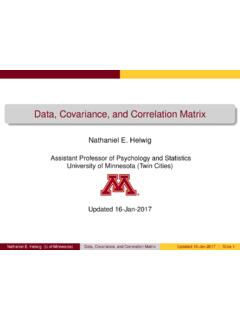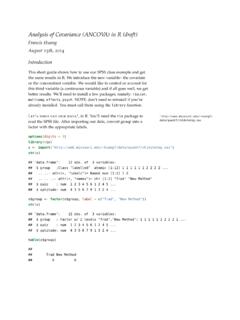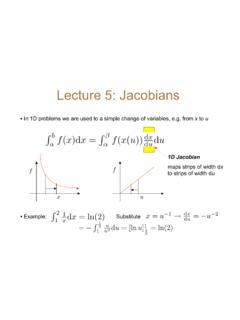Transcription of 198-30: Guidelines for Selecting the Covariance Structure ...
1 SUGI 30 Statistics and Data Analysis Paper 198-30. Guidelines for Selecting the Covariance Structure in Mixed Model Analysis Chuck Kincaid, COMSYS Information Technology Services, Inc., Portage, MI. INTRODUCTION. Mixed Models is rapidly becoming a very useful tool for statisticians. As a general paradigm it can be used to handle almost every situation, especially if you extend the Linear Mixed Model to the Generalized Linear Mixed Model case or the Nonlinear Mixed Model case. It's also an area in which a lot of research is being done, because the questions are far from being answered. Advanced computing power is giving us the capability to answer those questions.
2 One important question which, unfortunately, still has no good answer is how to select the Covariance Structure . This paper is an attempt to survey the information available for answering the question. SITUATIONS. Mixed Models, models with both fixed and random effects arise in a variety of research situations. Split plots, strip plots, repeated measures, multi-site clinical trials, hierarchical linear models, random coefficients, analysis of Covariance are all special cases of the mixed model. The question of Selecting the Covariance Structure changes with each case, as it does when you throw in missing values or missing treatment combinations. For this paper we will stick to the repeated measures situation with no missing values.
3 For example, suppose we are testing the efficacy of a new drug. We have two groups, treatment and control, and we are taking multiple measurements on each person in the two groups. BASICS OF MIXED MODEL. NOTATION. The Linear Mixed Model (LMM) is a generalization of the Linear Model (LM) and is represented in its most general fashion as Yi = X i + Z i i + i where Xi and Zi are the fixed and random design matrices, respectively, is a vector of unknown fixed effects, i is a vector of unknown random effects and i is the unknown random error. represents parameters that are the same for all subjects; represents parameters that are allowed to vary over subjects. Milliken [] is an excellent source for learning how to determine the appropriate terms for the given design and treatment structures.
4 We assume that the random effects are normally distributed with 0 G 0 . E = Var = . 0 0 R .. Given these assumptions, the variance of y , which is the reason we're all here, is V = Z G Z + R . We fit the random portion of the model by specifying the terms that define the random design matrix Z and specifying the structures of Covariance matrices G and R. MEANING. The random effects, as stated above, are allowed to vary over subjects. Another way to think of them is as subject- specific regression coefficients that reflect the natural heterogeneity in the population. Suppose site is a random effect. Then the effect of a particular site on the response, i , is different for each site.
5 The relationship among the effects of all of the sites is, we assume, described by a Normal distribution with mean 0 and variance, say, S . 2. The repeated measurements could be repeated either as multiple measurements taken on the same experimental unit at the same time or a single measurement taken on the same experimental unit at multiple times or a combination of the two. Moser provides an excellent overview of fitting both types of measurements. In this case suppose i = { i1 , i 2 , i 3 , , im } is a vector of measurements taken at m equally spaced time points. The measurements each come from a normal distribution with Covariance matrix 1. SUGI 30 Statistics and Data Analysis 11 21 1m.
6 2m . (). Ri = Var i = 21.. 22.. m1 m 2 mm . Since they are all taken on the same experimental unit the measurements are correlated with each other.. We note that, because the variance of y is made up of two components, Z GZ and R , we could model the Structure in G or R or both. DIFFERENT Covariance STRUCTURES. The table below lists the simpler Covariance structures that can be modeled in SAS via PROC MIXED. Each of these can be described in a fairly intuitive manner, though as we'll see they can be very similar to one another. Structure Description # of Parameters {i,j}th element AR(1) Autoregressive(1) 2. ij = 2 i j CS Compound Symmetry 2 ij = 1 + 21(i = j ).
7 UN Unstructured t(t+1)/2 ij = ij TOEP Toeplitz t ij = i j +1. VC Variance Components q ij = k2 1(i = j ) and i corresponds to the kth effect ARH(1) Heterogeneous AR(1) t+1. ij = i j i j CSH Heterogeneous CS t+1 ij = i j [ 1(i j ) + 1(i = j )]. TOEPH Heterogeneous TOEP 2t-1 ij = i j i j VARIANCE COMPONENTS. The VC Structure is the standard variance components and is the default. A2 0 0 0 .. 0 B. 2. 0 0 . 0 0 AB. 2. 0 .. 0 0 0 AB. 2.. AUTOREGRESSIVE(1). The AR(1) Structure has homogeneous variances and correlations that decline exponentially with distance. In our case this means that the variability in a measurement, say white blood cell count, is constant regardless of when you measure it.
8 It also means that two measurements that are right next to each other in time are going to be pretty correlated (depending on the value of ), but that as measurements get farther and farther apart they are less correlated. 1 2 3 .. 2 1 2 .. 2 1 . 3 . 2 1 . COMPOUND SYMMETRY. The CS Structure is the well-known compound symmetry Structure required for split-plot designs in the old days . As can be seen in the table, the variances are homogeneous. There is a correlation between two separate measurements, but it is assumed that the correlation is constant regardless of how far apart the measurements are. 2. SUGI 30 Statistics and Data Analysis 2 + 12 12 12 12 .. 1 2 + 12 12 12.
9 2. 2 12 2 + 12 12 . 1.. 1 12 12 2 + 12 . 2. UNSTRUCTURED. The UN Structure is the most liberal of all allowing every term to be different. It requires fitting the most parameters of any Structure , t(t+1)/2. 12 12 13 14 .. 12 2 23 24 . 2. 23 32 34 . 13 . 14 24 34 4 . 2. TOEPLITZ. The TOEP Structure is similar to the AR(1) in that all measurements next to each other have the same correlation, measurements two apart have the same correlation different from the first, measurements three apart have the same correlation different from the first two, etc. However, the correlations do not necessarily have the same pattern as in the AR(1). Technically, the AR(1) is a special case of the Toeplitz.
10 2 1 2 3 .. 1 1 2 . 2. 1 2 1 . 2 . 3 2 1 2 .. HETEROGENEOUS VERSIONS OF THE ABOVE. The heterogeneous versions of the Covariance structures above are a simple extension. That is the variances, along the diagonal of the matrix, do not have to be the same. Note that this adds more parameters to be estimated, one for every measurement. SPECIFYING THE Covariance Structure . PROC MIXED NOTATION. A lot of the notation for MIXED is similar to what is in GLM, but often the meaning is different. There are two ways to specify a Covariance Structure in PROC MIXED, the RANDOM statement and the REPEATED statement. The former specifies the Structure for the G matrix and the latter for the R matrix.










